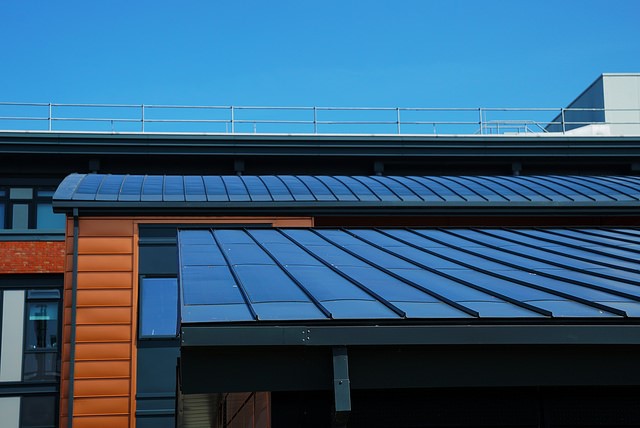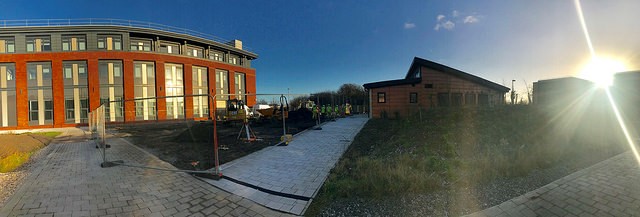Developing low carbon, affordable buildings is a key challenge for the construction industry. What if technology could be harnessed to create power-generating, “energy-positive” structures? Dr Justin Searle, technology director of the SPECIFIC Innovation & Knowledge Centre at Swansea University, discusses a project that is doing just that
Buildings currently account for around 40% of UK energy consumption. However, a new office, just opened in Swansea, points the way to a very different future.
Why not design buildings to be power stations that can generate, store and release their own energy?
If it sounds like science fiction, come down to Swansea, where we’ve just opened a building that shows it can work. We call it the Active Office. It is the UK’s first energy-positive office, capable of generating more solar energy than it consumes over the annual cycle.
The Active Office was designed by SPECIFIC, a national Innovation & Knowledge Centre led by Swansea University, with their key industrial partners, Tata Steel, NSG Group and AkzoNobel. SPECIFIC is leading change in construction, helping industry partners take new products to market by integrating them into new systems and demonstrating that they work.
We built the Active Office on Swansea University’s Bay Campus, with construction – from concept to completion – taking us just eight months. Much of the work was carried out elsewhere and then assembled on site.
The individual technologies we used in the Active Office are impressive, from an integrated solar roof to battery storage.
But what’s most significant is the fact that they all work together in one integrated system, generating, storing and releasing solar energy for heat and electricity.
The office has smart systems, including wireless access points and data infrastructure to support predictive operation, Internet of Things devices and smart building sensors. Extensive energy monitoring identifies sources and sinks of both electrical and thermal energy, providing information on how the energy is being distributed within the building
Significant too is the fact that all the technologies used are already commercially available, using existing supply chains. There is no reason why these could not be used on any new building.
The Active Office is also demonstrating how an energy-resilient community could work. It has been designed to share energy with another building next door, the Active Classroom, which was the UK’s first energy-positive classroom.
The Classroom, recently named Project of the Year by RICS Wales, has shown that the “buildings as power stations” concept works. In its first year of operation, it generated more than one-and-a-half times the solar energy it consumed.
Now that the Office is up and running, the two Active Buildings will able to share energy with each other, and with electric vehicles via three charging points. So what we have here are not just individual buildings, but a demonstration of an energy-resilient solar-powered community.
Let’s look at the individual technologies in use on the Active Office:
- The first curved integrated PV roof by BIPVco, which demonstrates the flexible nature of the 23kWp photovoltaic panels.
- 110kWh lithium ion phosphate batteries.
- First commercial installation of a wall-mounted photovoltaic thermal (PVT) system – capable of generating both heat and electricity – by Naked Energy.
- 2,000-litre water-based solar heat store capable of storing sufficient energy to provide space heating for the following day, (enabling time-shifting of electrical heating demand).
- Heating derived from solar energy by a combination of solar thermal, air source heat pump and an immersion heater. There is no gas supply in the building. A smart controller will use occupancy and weather forecasting information to optimise charging of the 2,000-litre cylinder.
- Three electric vehicle charging points.
- Steel cladding – Colorcoat Urban® on the external walls and roof and Coretinium internal wall cladding from Tata Steel.

As this list shows, while SPECIFIC has led the project, the Active Office has been a team effort from start to finish. The highly accelerated design and development timeline required extensive collaboration throughout the supply chain to ensure that deadlines were met, without sacrificing innovation or the aspiration of being energy positive.
Partners in the project include Wernick, for offsite building manufacture and construction management; Tata Steel, whose products include the Colorcoat Urban® cladding and roof panels; and Cisco Systems, who have developed the networking infrastructure and electric vehicle management systems.
Smaller collaborators include BIPVco, developer of the integrated solar roof; Naked Energy, whose photovoltaic-thermal devices are capable of generating electricity and heat at the same time; and Dulas, who supplied the battery system.
The Active Office was funded by Innovate UK with support from Swansea University and the European Regional Development Fund through the Welsh Government. SPECIFIC also receives funding from the Engineering & Physical Sciences Research Council.
Now that the Office is open and in use, we will be gathering data to see how it works. As with the Active Classroom, this will help us refine the design.
Developing low-carbon affordable buildings is one of the biggest challenges for the construction industry of the 21st century. With the Active Office and Classroom, we are showing how buildings can be power stations, helping us meet that challenge. Come and see. Swansea just may be where the future is happening first.
Dr Justin Searle
Technology Director
SPECIFIC Innovation & Knowledge Centre,
Swansea University
Tel: +44 (0)1792 606867
Twitter: @info_specific
LinkedIn: Specific-ikc
Youtube: Specificikc Videos











